Hagar and Rosh Hashanah
“After these things, God tested Abraham…” (Genesis 22:1). What things? The midrash demands that the wording, “after these things” means something immediately after. We, on the second day of Rosh Hashanah, mentally experience these words immediately after the first day’s reading. That reading starts with the miraculous birth of Isaac, thirty-seven years earlier.
Then the very grown-up conflict with his half-brother Ishmael and the climatic narrative of the expulsion of Hagar and Ishmael unfolds. Abraham is willing to sacrifice each of his sons at God’s command. Ishmael and Hagar in the wilderness is the first of these two instances. Hagar’s expulsion and her anguish in the wilderness therefore must color our understanding of Rosh Hashanah’s primal narrative, the Akeidah.
Camille Corot (1796-1875), perhaps the most revered French landscape painter of the early 19th century, painted Hagar in the Wilderness relatively early in his career in 1835. At that time it was the “most ambitious and arguably his most successful painting to date…” It would be one of a handful of biblical and religious paintings out of the hundreds of highly lauded works he produced. It is entirely distinctive from all depictions of this subject in that it places the distraught Hagar and the unconscious Ishmael in the midst of a vast landscape. Giant boulders threaten to overwhelm them as much as the oversized vegetation. In the distance imposing cliffs punctuate a spare, barren landscape equally derived from the artist’s recent studies of the Roman countryside merged with images from his native French landscape. Be that as it may, the one thing they share is an intensely clear light. It is the amazing light that reveals the terrible drama unfolding below observed by the angel approaching in the distant sky above.
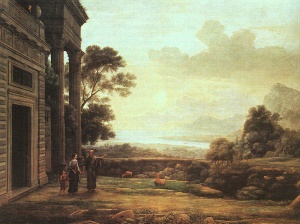
Another French landscape master, Claude Lorraine (1604–1682), tackled an alternative aspect of the Hagar narrative in 1668 with The Departure of Hagar and Ishmael currently at the Alte Pinakothek, Munich. Here the drama is greatly subdued. Abraham is cordially asking Hagar and the very young Ishmael to leave the neoclassical mansion that serves as the patriarch’s home. The landscape that makes up the vast majority of the painting is calm and bucolic, nary a hint of a threatening wilderness that will soon threaten Ishmael’s life. Only upon close examination do we see that a head appears at the top of the entranceway, certainly Sarah overseeing the expulsion of her hated rival.
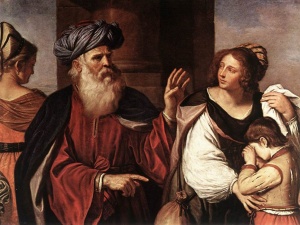
Depictions of the dismissal of Hagar and Ishmael are perhaps the most common episode found in the 17th and 18th century artwork of the Hagar narrative. Its potential for human drama and familial conflict make it a favorite of the Baroque sensibility. Giovanni Francesco Barbieri (1591-1666), known as Guercino, was one of the greatest Italian Baroque painters and his Abraham Casting Out Hagar and Ishmael (1657) is considered a masterpiece of his mature style. The scale in all depictions of this scene is intimate, ranging from a close-cropped image to a slightly broader depiction of figures within a very narrow context. In the Guercino the figures are arranged as if in a psychological frieze, the three principles in a row. The weeping child Ishmael breaks the pattern thereby emphasizing it. Abraham’s admonition to Hagar betrays no emotion while Hagar seems to plead for mercy from the patriarch. The stern Sarah has her back to us, silently triumphant. Perhaps more than any other depiction, this proposes Abraham as uncompromising, unwilling to have compassion on his former mate and their son; pure Christian doctrine of Jewish cruelty that flies in the face of the biblical text.
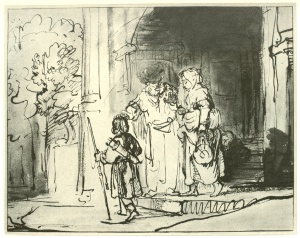
Rembrandt did at least 7 drawings of the Hagar narrative and his Dismissal of Hagar and Ishmael (1640-43), British Museum, London, is perhaps the most touching. The lad Ishmael is seen from behind with his quiver and bow, all youthful confidence. His mother has bundled up her few possessions and is sadly contemplating life outside her adopted home. Abraham is between them patiently explaining the necessity of their expulsion. Abraham’s left hand is gesturing to Hagar that she need not worry. But it is his right hand that drives the narrative. He has placed his hand on his son Ishmael’s head in blessing, a final expression of his love and concern for his first-born son. Here Rembrandt exposes an inner core of the biblical narrative. As the text makes perfectly clear, Abraham had great affection for Ishmael and only reluctantly listened to Sarah’s prophetic voice concerning the expulsion of Hagar and Ishmael.
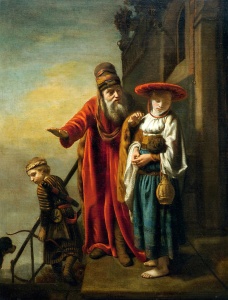
Around the same time and in the same locality, two other artists treated the same subject. Nicolaes Maes (1634–1693), a one-time student of Rembrandt, painted The Dismissal of Hagar in 1653 (Metropolitan Museum of Art, New York) utilizing the same theme and echoing the same composition of the earlier Rembrandt drawing. Here a sullen Ishmael exits with bow and arrow. So too Hagar is distressed, her delicate face partially in shadow and turning away from the empathetic patriarch. The gesture of his right hand approximates the blessing found in Rembrandt’s drawing, but here misses its mark since in space the hand is out of line with its subject, Ishmael. The engaging themes of this painting is how sincere Abraham seems in trying to explain to the concubine Hagar how he has been forced to expel her from her adopted home and the brooding resentment in Ishmael’s expression that seems to foretell a deeply troubled future.
Gabriel Metsu’s (1629–1667) Dismissal of Hagar, painted in 1653 when the artist was 24 years old, is yet another example of this aspect of the Hagar narrative. Menachem Wecker’s analysis of this painting in his April 28, 2011 column correctly notes the importance of dogs as symbols of fidelity in these Dutch 17th century biblical narratives. There is a dog barely seen in the shadows behind Hagar in Rembrandt’s drawing, one again appears at the base of the stairs just beyond Ishmael in Maes’ version and now in Metsu the artist brings them front and center. Their role in this subject is deeply anti-Jewish, a reflection of Christian distain of Abraham’s rejection of Hagar and Ishmael. In all of these images the dog, the symbol of loyalty, is being kicked out of the house along with Hagar and her son. In this context Abraham is seen as scorning the loyal maidservant, her son and even the faithful dog. Subtle though it is, these images are ultimately a screed against the Jews.
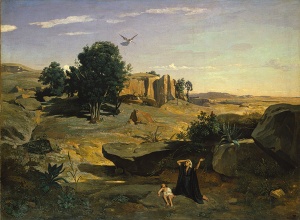
![Hagar in the Wilderness [Detail] (1835) oil on canvas by Camille Corot Courtesy The Metropolitan Museum of Art, New York Hagar in the Wilderness [Detail] (1835) oil on canvas by Camille Corot Courtesy The Metropolitan Museum of Art, New York](https://richardmcbee.com/wp-content/uploads/2011/09/Corot_met_detail-300x183.jpg)
But Camille Corot doesn’t know about any of this. He only intuits a Divine intervention, driven by the biblical text that seems significant. The desperation of Hagar, a mother confronting the death of her only son, is what drives the image. She is lost in a landscape that is ironically clear and yet threatening. Beautiful and yet deadly.
Behind her in the distance, high above the cliffs and the trees is a winged angel. We are meant to deeply feel that distance, the disjunction between the threat and the far-off salvation to savor the drama of Hagar’s trial. And of course that is exactly the biblical message the text conveys to us on the first day of Rosh Hashanah.
For all of our preparations in the month of Elul, now on Rosh Hashanah we begin in earnest the desperate process of return and repentance. As in Corot’s painting, the angel of salvation is far away. On this day we call out for ourselves and all those we love. Who will live and who will not. Corot’s image posits us on this terrible precipice.